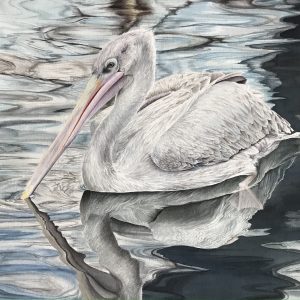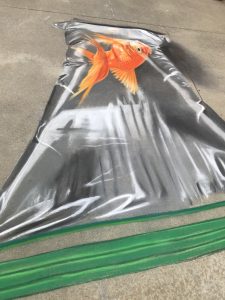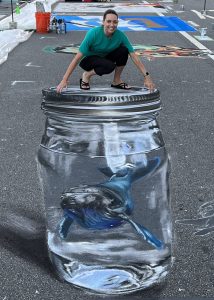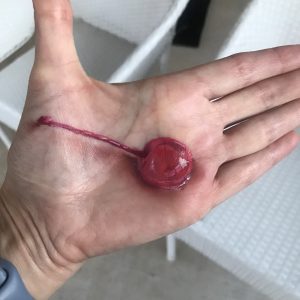Finding Beauty in the Temporary
One of the greatest things about Fort Worth is its vibrant art scene. One might be surprised to learn just how many talented artists live and work here.

One Fort Worth artist, Jan Riggins, is a woman who can create beautiful images no matter the medium or style. Whether it’s watercolors or chalk; in two dimensions or three; on the ground, on canvas, on a wall, or on the body, Jan creates beautiful and wondrous things.

photo credit: Jan Riggins
When I met Jan, she was kind enough to give me a tour of her home gallery. The first thing I noticed were the watercolors. The walls were lined with portraits of animals, drawn with a level of realism and detail that I did not know was possible from watercolors. Among the animals were lions, zebras, birds, and more, all strikingly beautiful. Jan explained to me just how intensive the process was to create these works of art. Each one took weeks of meticulous work and an almost pathological attention to detail. Water coloring was Jan’s preferred medium for the longest time, but that began to change a few years ago.
Jan did not set out to become an artist. Growing up in Norman, Oklahoma, Jan was a talented clarinetist, competing throughout high school and college. Her mother and grandmother were visual artists, and those art genes and the love of creating are strong. While working in a “real job,” she realized that she had to do something, anything, to let her creative side free. Her interest in chalk art began during the Covid shutdown in March of 2020, when Jan and her daughter began to use their driveway as their canvas. Intrigued with the possibilities of this new medium, Jan dove headfirst into the world of three-dimensional chalk art.

photo credit: Jan Riggins
Chalk is a very different medium from watercolors, and making the works seem three dimensional just adds more challenges, but Jan adapted wonderfully. Luckily for her, there is a thriving, although comparatively small, chalk art community that was willing to help her out. Chalk art typically is showcased in chalk art festivals, and Jan has been to many of those, travelling to places like Atlanta, Minnesota, and Michigan to “perform.” I say “perform” because there is a definite element of performance to it. Part of the fun of chalk festivals is to watch the artists create their art. Artists are expected to interact with the crowd, answering questions and showing the crowd how the art is made. This can be helpful especially in the case of three-dimensional chalk art, which is a long and difficult process from planning to completion.
Most artists at chalk art festivals content themselves with creating two-dimensional art. They don’t want the headaches associated with three-dimensional chalk art. Three-dimensional chalk art requires a huge amount of preparatory work before the festival even begins with no guarantee the final image will work, making it a risky choice when you only have a weekend to create a piece of work that is, in the end, completely transitory. There is no starting over when it comes to three-dimensional chalk art.

photo credit: Jan Riggins
A three-dimensional art piece is only as good as its preparation. Typically, the artist meticulously plans the piece on a grid. Each square of the grid represents a square foot of pavement, with the grid acting as a map for the artist. Creating the grid is one of the hardest parts of the whole project. The artist must stretch and contort their image in just the right way to achieve the three-dimensional effect, making the image look very strange in two-dimensions. After the grid is completed, the artist follows the map, recreating the image on the ground. It is intensive, backbreaking work, often taking a full weekend to complete an image.
Once the piece is finished, it can be fully enjoyed by the crowd, but to get full effect, it must be viewed in the right manner. Three-dimensional art depends on perspective. There is one perfect place to stand to experience the three-dimensional effect, and it really helps to view the art through the lens of a camera, which will capture the work forever. Chalk is temporary. That, however, is one of the things that make chalk art festivals so fun. You get to be one of the few people who can see the art in person as it was meant to be seen. You get to watch the artists as they create their art before it gets washed away. The journey is more important than the destination.

photo credit: Jan Riggins
Chalk art is not the only temporary art Jan makes. She has recently started experimenting with body art. Using peoples’ hands as a canvas, Jan uses the skin’s texture and the shadows created by the bones and sinews to create paintings of nature and animals, which has always been her preferred subject matter. The works are temporary like the chalk, but photography allows them to stick around forever.
Jan Riggins is truly gifted artist. Whether her canvas is the ground, the body, or actual canvas does not matter. She utilizes all of them to full effect, and the results are beautiful no matter what. Those art genes. They’re strong.
 Eric Zukoski is a senior at the University of Texas. He is interning with Madeworthy.
Eric Zukoski is a senior at the University of Texas. He is interning with Madeworthy.


 Sign in
Sign in

